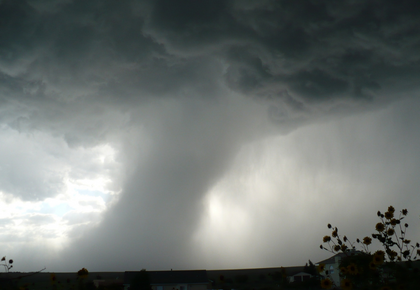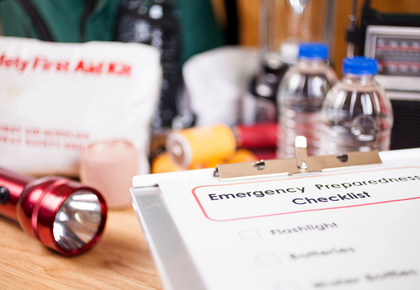It’s no secret that Illinois sees its fair share of severe weather and on a more regular basis. Severe thunderstorms, high winds and tornadoes touching down are something everyone should be prepared for. Tornadoes are fearsome because of their unpredictable nature. While certain weather conditions make tornadoes more likely, such as severe summer thunderstorms, the reality is they can strike at any time of year and almost any place, even forming over water and moving onto land. While Illinois may not be part of tornado alley, the state typically averages around 50 tornadoes per year.

“Of course, you can’t prevent severe weather, but you can make sure your community is as prepared and as ready as possible, especially if you live in a region that experiences tornados," said Asa Sherwood, president of FirstService Residential Illinois. "When a dangerous storm arises without warning, there are things that can be done for your community to minimize potential injury and damage and get through it as safely as possible."
If you’re a member of your homeowners association board, you’ll want to take additional measures to protect your residents and property as well. One of the most important things you can do is make sure your residents are informed about the risks of dangerous storms and how to respond.
Ways to keep emergency preparedness top of mind for your residents include providing emergency response information on a regular basis, perhaps within a quarterly newsletter. For more in-depth information, you can prepare a handbook that is updated on an annual basis and provided to residents and/or housed in easy to find places throughout the community. When serve weather is on its way, we also recommend sending out a notice to remind residents to remove anything from their balconies that could get picked up by the wind that could become a real danger to residents and cause additional damage.
If your community is partnered with a quality property management company, you can rely on them to assist with immediate communications to residents during an emergency using a system that can send texts, emails, and phone calls. Let’s take a look at some of the things you, as a board member, should be communicating to residents about what they should do to prepare for severe weather.
1. Understand the Basic Terminology of Severe Weather Including Tornadoes
It’s important to understand standard weather terms used by the different government agencies and the media to describe their severity and probability of different types of storms. A tornado watch means that conditions favor the formation of tornadoes, so stay tuned to emergency broadcasts and be ready to take shelter. A tornado warning is issued when a funnel cloud is sighted or indicated by radar – if so, take shelter immediately.
To make sure you are aware of watches and warnings, install a reliable weather app on your smart phone and make sure it’s set to send you notifications of potentially dangerous conditions.
2. Know the Signs in the Sky
Did you know that tornadoes can form without thunderstorms? If you see dark or green-colored (almost bruised looking) skies, a low-flying cloud that is large and dark or big chunks of hail, it could mean a tornado is approaching – same goes for noises that sound like a rumbling freight train. If you see or hear any of these telltale tornado indicators, take shelter immediately. If you see a funnel cloud, get somewhere safe right away. If possible, take the opportunity to alert your local first responders, or broadcast stations – but only if time permits and it doesn’t delay your move to safety.

3. Create a Plan for Where to Go and What to Do
In certain places, it’s not a question of whether a tornado will strike, but when. No matter where you live, it makes good sense to prepare in advance so you’re ready to react quickly if you ever need to. Start by identifying where to seek shelter if a tornado should touch down. Select an area without windows, and on the lowest floor possible. If you have a basement, use it. If you’re in a high rise, taking shelter in your closet or bathroom is recommended. Make sure that access to it is clear – nothing on the stairs, nothing blocking the door – so you can get into it quickly. Practice tornado drills with your family so they know where to go. Make sure everyone knows how to shut off the power, water, and gas – and just in case, knows the location of the family first aid kit. If you can, store a kit in your safe room at all times. Keep fire extinguishers handy and teach everyone in your home how to use them. You’ll also want to have fresh batteries and a battery-powered TV or radio on hand to stay informed if the power goes out.

4. Keep Important Papers Close by and Duplicated Elsewhere
Keep a list of important information close by (in your safe room if possible), including emergency contact numbers and the names and numbers of your close neighbors, insurance agent, property manager and/or landlord. In addition, compile your insurance policy numbers and important information about your family’s medical conditions and prescriptions, vehicles, and bank account numbers. You may also want to document how to access radio and TV stations that may broadcast important emergency storm information. Make sure important documents like birth certificates, social security cards, insurance policies, wills, and documentation of your home’s contents (lists and photographs) are stored in a water- and fire-proof safe or a safety deposit box at your bank, or both. It’s also a good idea to have all this information scanned and backed up to an offsite or cloud storage service.
5. Take Shelter the Right Way
-
If you're at home during a tornado, seek shelter in your designated safe room.
-
You may also want to cover each family member's body with a blanket, sleeping bag or mattress to prevent injury from flying glass or debris. If there's a sturdy table in the room, everyone should get under it.
-
If you're in your car, don't try to outrun the tornado – you can't. Instead, pull over – preferably in an area that is lower than the road – and secure your seat belt, lower your head below window-level and cover your body with a blanket or jacket. Don't try to park beneath a bridge or overpass – they're actually not as safe as they may appear.
-
If you're outdoors on foot, seek shelter immediately – even if it's inside a stationary vehicle.
-
As a last resort, lie down in the lowest-lying area of ground you can find and cover your head with your hands.
These tips are a good start to help you prepare for the worst. For more valuable storm safety information and guidelines, check out the helpful resources below:
Centers for Disease Control
Red Cross
Department of Homeland Security
Occupational Safety and Health Administration